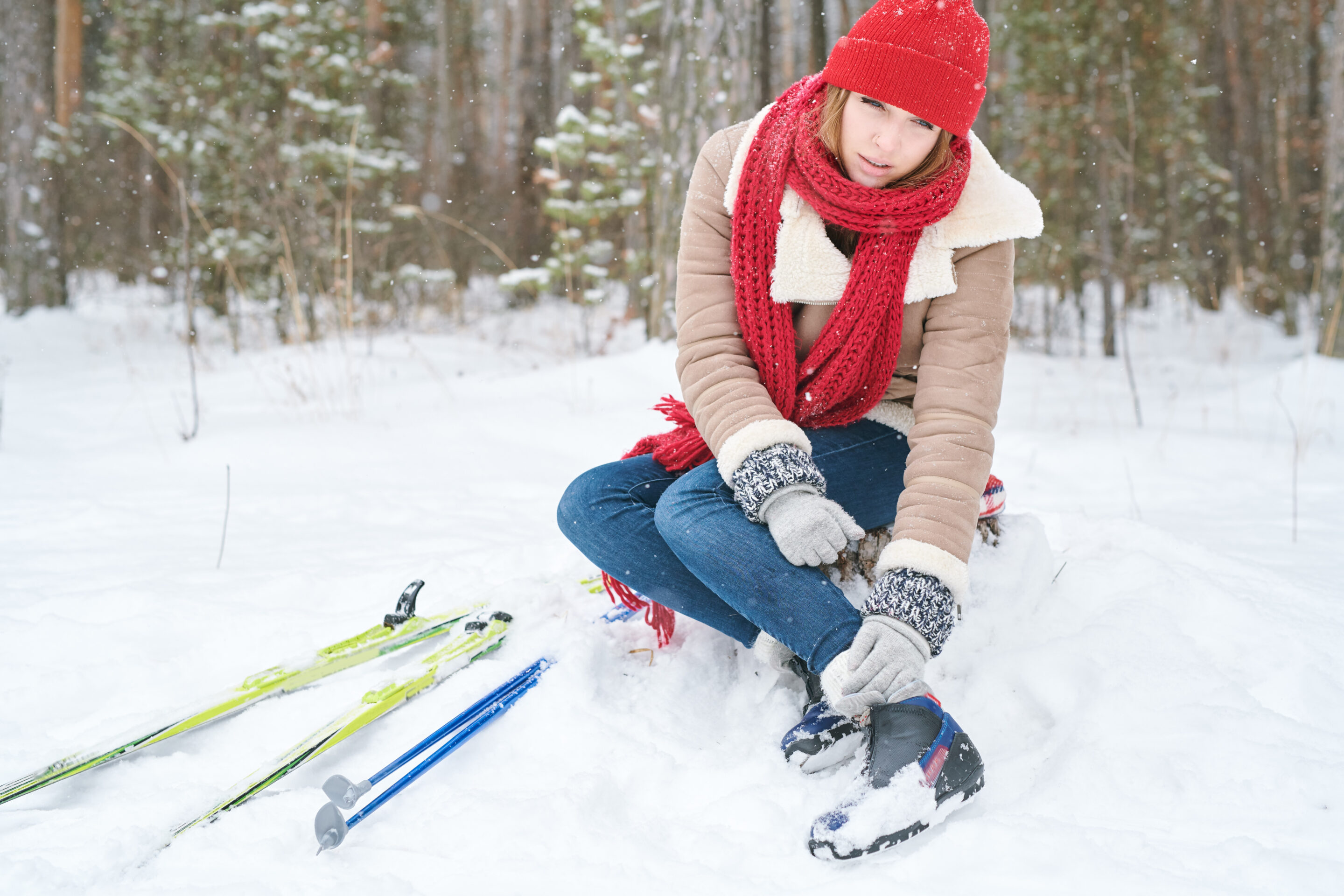Treating Common Winter Sports Injuries
Any responsible skier or snowboarder knows it’s important to take good care of your feet, ankles, and boots when enjoying winter sports. Sprains, fractures, and frostbite are often cited as the more common injuries in winter due to all the ice and snow. However, there are a few other potential problems that often arise as well.
At McVay Foot & Ankle, as experts in treating and healing sports injuries, below we’ll go over a few of the more common winter injuries. You’ll find some helpful tips for averting any seasonal disaster, as well as the immediate steps you can take to reduce the downtime from these all-too-common winter injuries.
Common Winter Sports Injuries
Winter sports activities can place plenty of stress on the feet and ankles, the most common being sprains, fractures, and frostbite. Even shoveling your walkway or walking up a frozen sidewalk can potentially cause unexpected trauma.
Less known but extremely common to winter sports enthusiasts are the following injuries, worth watching out for. You may want to bookmark this page to quickly see what steps to take to prevent or treat these winter injuries.
Subungual Hematoma
Often known as “skier’s toe” or “bang toe,” this injury involves trauma to the toe that causes bleeding beneath a toenail. This common injury tends to happen on the slopes as a result of ill-fitting boots, which cause the toes to smash into the hard front of the boot, as well as when a skier shifts their weight sharply backward to steady themselves, forcing their toes to crash against their boot tops.
Snowboarders are somewhat less vulnerable to this condition since their boots tend to be more padded on the inside, but it can still occur.
Often, the pain of a subungual hematoma is intense. For this reason, the blood beneath a blackened nail should be relieved as quickly as possible. Many ski resorts will have a clinic where they should be able to perform this service. Though call us immediately if you cannot access such a clinic. Never attempt to try to drain the nail yourself.
To prevent skier’s toe, ensure your boots fit properly and are not too small. Also, train yourself to handle weight shifts and bailouts. In this way, you’ll place your toes at lower risk.
Morton’s Neuroma
Affecting the toes and feet, Morton’s neuroma is caused by a buildup of benign tissue around a nerve in the ball of the foot. Most often, this is the result of excess pressure and other impacts on that area. Footwear that compresses the toes and forefoot is often the primary cause of Morton’s neuroma, a very common ailment among skiers, snowboarders, and ice skaters.
If you need to see us for a neuroma, definitely bring with you your boots, skates, or other frequently worn footwear. This can greatly help us narrow down the source of the problem.
Neuroma treatments may include changes to footwear, allowing toes more freedom and far less compression. At times, cushioned pads or custom orthotics can provide further relief from the pressure.
In some cases, a steroidal injection into the forefoot can also help reduce the pain and inflammation. We use ultrasound-guided technology to ensure we treat the precise area where the injection will have the best effect.
Blisters
Long days out in icy snow can lead to the formation of blisters. The more friction, heat, or moisture inside your footwear, the far more likely blisters will develop over time.
Using boots or skates throughout the day that contain ‘hot spots’ of friction will be abrasive to the feet. Combined with a buildup of moisture, this further prevents comfortable movement.
Blisters can often be treated rather easily at home. Try, as much as possible, to leave a blister intact. If you can, leave the ‘unpopped’ blister exposed so that it can breathe and dissolve safely; or cover it with a loose bandage if needed.
A word of caution: If your blister does pop, don’t remove the excess skin. That skin is still providing some needed protection, the lack of which will likely cause even greater pain and discomfort. Instead, gently wash the area with soap and warm water, apply an antibiotic ointment, then cover it with a bandage or a band-aid.
However if your blister is particularly painful, or in a problem area, give us a call. We can help you safely drain it, then treat the area as needed.
Sprains and Fractures
Of course these were going to make the list. No matter how well you prepare yourself, accidents can occasionally still happen. If you suspect a sprain or break, halt your activity and take the weight off the affected leg or foot as soon as possible.
Once you get back indoors, apply a wrapped ice pack (yes, ironic isn’t it) for up to 20 minutes. Do so several times during the next 48 hours to reduce further pain and swelling.
As soon as you’re able to, call us! We can provide you with individual recommendations, as these injuries are more serious and require a professional evaluation and treatment options.
Even a minor sprain–if not healed correctly–can lead to instability and a greater chance of additional injuries in the future.
Frostbite
Frostbite can cause mild to permanent damage, including amputation. If you suspect frostbite, very slowly rewarm the affected area by placing it in warm water–not hot. The recommended water temperature is between 98.6F to 102.2F ( or 37C to 39C ). Try to rewarm the affected area this way for at least 30 minutes, or until that body part can easily move and is a red-purplish color.
Additional ways for treating frostbite may also include:
- Oral pain medicine
- Infection-fighting medicine
- Clot-prevention medicine
- Removal of damaged tissue
- Treatment and wound care.
For a thorough evaluation, contact our office or another specialist dealing with frostbite injuries to obtain a professional recommendation and receive treatment options.

Treating and Preventing Winter Sports Injuries
Accidents do happen. At times, acute injuries are simply unavoidable. That doesn’t mean you can’t take steps to reduce or prevent your chances of becoming injured. Some of our most useful advice for preventing winter wounds and foot trauma include the following.
Always wear properly fitting footwear, with well-adjusted, working fastenings. Also, make sure your footgear is weather appropriate, with ample room for the toes to bend. If you’re renting boots, walk around in them first to assure they’re a good fit before committing to using them.
Before you start, warm up for a few minutes. Heel lifts, long lunges, light jogging, and other stretching and elongating motions will warm up the feet, ankles, and calves.
Don’t push yourself beyond safe limits. Listen to your body. Fatigue often opens up fresh opportunities for injury, especially during long endurance periods of repetitive motions or impacts. Instead, cross-train to help you build up endurance while still limiting repetition.
We hope everyone’s winter is safe and injury-free. If misfortune does occur, we hope you can heal and get back to the slopes as quickly and safely as possible.
Your Go-To for Winter Sports Injuries Experts
We at McVay are experts in providing the specialized podiatry care that you need. When it comes to your feet, even small injuries can have drastic consequences when left untreated. If something doesn’t feel right or isn’t healing well, just reach out.
Call our Colorado Springs office for an appointment at (719) 266-5000 or fill out our online contact form. We also have telemedicine appointments available for those who prefer it.
Whatever your issue or injury, we’ll help you receive a thorough podiatry evaluation and then provide you with professional treatment options so you can quickly heal. Find out why McVay’s Foot & Ankle experts are the best around.
© McVay Foot & Ankle. All Rights Reserved
Web Design by CP Solutions
Marketed by VMD Services
Privacy Policy | Terms & Conditions

